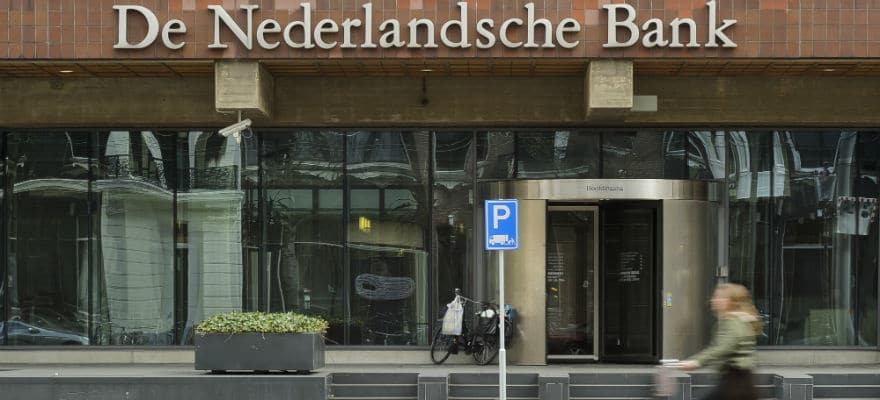Aleksi Grym, Head of Digitalisation at the Bank of Finland, has released a paper in which he calls cryptocurrency a fallacy.
The document argues that it is a myth that intermediaries can be avoided in a financial system, and that currency cannot have intrinsic value without central backing.
Great illusion
"The great illusion of digital currencies" is a 17-page document that was written, explains Grym, to bring clarity to a public whose sense of fact and fiction have been muddled by the internet and social media.
He begins by defining money. Citing numerous economists, he reviews the concepts of commodity money, fiat money, medium of exchange, store of value, and means of payment. He concludes: "What is common to most definitions in the literature is that money is defined based on what it does and not what it is."
Unit of account
Unit of account refers to a metric of value, such as is used in bookkeeping. Grym says that money was a unit of account before it was a medium of exchange; goods were priced before being traded.
It can thus be argued that all money is simply a unit of account, and banknotes and coins are physical representations of this. He argues that this is the best fundamental definition of what money is.
Banks
Money in today's world is created by the banking system of central and commercial banks. Both entities create money by lending - central banks to commercial banks and commercial banks to the public.
New money is backed by collateral, and thus not created out of thin air. The collateral of fiat money is price stability, meaning that it retains its value relative to all goods and service in the system. In theory, this is a stronger form of backing than a single commodity.
Intermediaries are still there
Grym argues that a Blockchain
Blockchain
Blockchain comprises a digital network of blocks with a comprehensive ledger of transactions made in a cryptocurrency such as Bitcoin or other altcoins.One of the signature features of blockchain is that it is maintained across more than one computer. The ledger can be public or private (permissioned). In this sense, blockchain is immune to the manipulation of data, making it not only open but verifiable. Because a blockchain is stored across a network of computers, it is very difficult to tamp
Blockchain comprises a digital network of blocks with a comprehensive ledger of transactions made in a cryptocurrency such as Bitcoin or other altcoins.One of the signature features of blockchain is that it is maintained across more than one computer. The ledger can be public or private (permissioned). In this sense, blockchain is immune to the manipulation of data, making it not only open but verifiable. Because a blockchain is stored across a network of computers, it is very difficult to tamp
Read this Term is essentially a record-keeping mechanism, which is the role filled by banks in the fiat money system. Bitcoin was built to avoid banks, and so uses a peer-to-peer system where instead of accountants we have miners. Data is not actually sent from sender to recipient, but from sender to the ledger.
Thus, intermediaries are always used. The fact that they are randomly assigned is irrelevant.
No such thing as a decentralised ledger
Grym argues that all the transactions on a blockchain network are stored in centralised ledger. The fact that all within the system have a copy of the ledger and can add to it is irrelevant - these are all copies of a single ledger.
Furthermore, he argues, blockchain rewards are no different to banks being 'rewarded' for processing Payments
Payments
One of the bases of mediums of exchange in the modern world, a payment constitutes the transfer of a legal currency or equivalent from one party in exchange for goods or services to another entity. The payments industry has become a fixture of modern commerce, though the players involved and means of exchange have dramatically shifted over time.In particular, a party making a payment is referred to as a payer, with the payee reflecting the individual or entity receiving the payment. Most commonl
One of the bases of mediums of exchange in the modern world, a payment constitutes the transfer of a legal currency or equivalent from one party in exchange for goods or services to another entity. The payments industry has become a fixture of modern commerce, though the players involved and means of exchange have dramatically shifted over time.In particular, a party making a payment is referred to as a payer, with the payee reflecting the individual or entity receiving the payment. Most commonl
Read this Term.
"If banks are not involved, then the system cannot possibly transfer money."
Grym argues that Satoshi Nakamoto never solved the problem of transferring money. Money is defined as a promise by a bank to convert an account entry into purchasing power. Account entries in a blockchain are meaningless because no bank is involved and thus it "does not refer to any actual deposited asset".
Where is the liquidity?
The characteristic that makes money so useful is its liquidity, a concept referring to its ease of use as a common medium.
Nakamoto's description of banks as purely transaction processors is incorrect because they also provide liquidity. A bank would need to provide liquidity for Bitcoin to be used as a unit of account, but in such a case the peer-to-peer network would become unnecessary because "the system would be indistinguishable from a core banking system."
"No practical difference"
A banking system consists of a set of accounts, a unit of account, and a ledger where all transactions are recorded. In a blockchain, this ledger is distributed, and in a bank, it is contained in a central computer system. The fact that the nodes in a blockchain are anonymous is irrelevant; there is no practical difference between what the two systems do.
Imaginary tokens, intrinsic value, and advertising
The claim that an account holds digital tokens is "fundamentally false" because "no tokens exist in reality".
Nakamoto knew that the system would not function if Bitcoin were perceived as having no value. Bitcoin miners and hodlers had the same problem; their account entries were meaningless. And this is why they began to advertise the value of Bitcoin with the story of a new monetary system. In this way, Bitcoin eventually became exchangeable for real money.
Grym postulates that possible explanations for market demand for Bitcoin are its usefulness in criminal activity, its brand identity, a sense of belonging to a community, and a feeling of security against state oppression. In other words, it has gained intangible value in a similar way to products such as toys, fashion, and art, but "this demand has not turned Bitcoin units into money."
Two use cases
Grym presents two theoretical situations in which a cryptocurrency could become money. The first is if a central bank were to issue a cryptocurrency alongside its fiat; in such a case, operating a peer-to-peer network would become a redundant exercise.
In the second, Bitcoin becomes the sole currency of a country. In such a case, based on the historical evolution of currency, Grym argues that reserves would be created because a growing economy would need an increasing amount of cash, such that the fixed total of Bitcoin could not provide, and so credit and lending would develop.
Thus these reserves would function as banks, and eventually, the reserves would be concentrated into a single bank - a central bank if you will. Physical currency would eventually be issued based on these reserves.
Ultimately, the basis of monetary policy would be moved from Bitcoin to inflation targeting, just as it is was found to be unfeasible to base it on gold. "Money would become fiat, Bitcoin a pure commodity, and there would no longer be any connection between the two."
Conclusion
Grym argues that it is a false perception that money can exist in only one form, and it is impossible for it to function as a unit of account without central backing. Many central banks are considering releasing their own cryptocurrencies, but as these would be backed by fiat money, these would be pointless exercises.
To conclude, the Bank of Finland's Head of Digitalisation says: "The concept of digital currency is therefore a fallacy, as currency cannot be digitised."
Aleksi Grym, Head of Digitalisation at the Bank of Finland, has released a paper in which he calls cryptocurrency a fallacy.
The document argues that it is a myth that intermediaries can be avoided in a financial system, and that currency cannot have intrinsic value without central backing.
Great illusion
"The great illusion of digital currencies" is a 17-page document that was written, explains Grym, to bring clarity to a public whose sense of fact and fiction have been muddled by the internet and social media.
He begins by defining money. Citing numerous economists, he reviews the concepts of commodity money, fiat money, medium of exchange, store of value, and means of payment. He concludes: "What is common to most definitions in the literature is that money is defined based on what it does and not what it is."
Unit of account
Unit of account refers to a metric of value, such as is used in bookkeeping. Grym says that money was a unit of account before it was a medium of exchange; goods were priced before being traded.
It can thus be argued that all money is simply a unit of account, and banknotes and coins are physical representations of this. He argues that this is the best fundamental definition of what money is.
Banks
Money in today's world is created by the banking system of central and commercial banks. Both entities create money by lending - central banks to commercial banks and commercial banks to the public.
New money is backed by collateral, and thus not created out of thin air. The collateral of fiat money is price stability, meaning that it retains its value relative to all goods and service in the system. In theory, this is a stronger form of backing than a single commodity.
Intermediaries are still there
Grym argues that a Blockchain
Blockchain
Blockchain comprises a digital network of blocks with a comprehensive ledger of transactions made in a cryptocurrency such as Bitcoin or other altcoins.One of the signature features of blockchain is that it is maintained across more than one computer. The ledger can be public or private (permissioned). In this sense, blockchain is immune to the manipulation of data, making it not only open but verifiable. Because a blockchain is stored across a network of computers, it is very difficult to tamp
Blockchain comprises a digital network of blocks with a comprehensive ledger of transactions made in a cryptocurrency such as Bitcoin or other altcoins.One of the signature features of blockchain is that it is maintained across more than one computer. The ledger can be public or private (permissioned). In this sense, blockchain is immune to the manipulation of data, making it not only open but verifiable. Because a blockchain is stored across a network of computers, it is very difficult to tamp
Read this Term is essentially a record-keeping mechanism, which is the role filled by banks in the fiat money system. Bitcoin was built to avoid banks, and so uses a peer-to-peer system where instead of accountants we have miners. Data is not actually sent from sender to recipient, but from sender to the ledger.
Thus, intermediaries are always used. The fact that they are randomly assigned is irrelevant.
No such thing as a decentralised ledger
Grym argues that all the transactions on a blockchain network are stored in centralised ledger. The fact that all within the system have a copy of the ledger and can add to it is irrelevant - these are all copies of a single ledger.
Furthermore, he argues, blockchain rewards are no different to banks being 'rewarded' for processing Payments
Payments
One of the bases of mediums of exchange in the modern world, a payment constitutes the transfer of a legal currency or equivalent from one party in exchange for goods or services to another entity. The payments industry has become a fixture of modern commerce, though the players involved and means of exchange have dramatically shifted over time.In particular, a party making a payment is referred to as a payer, with the payee reflecting the individual or entity receiving the payment. Most commonl
One of the bases of mediums of exchange in the modern world, a payment constitutes the transfer of a legal currency or equivalent from one party in exchange for goods or services to another entity. The payments industry has become a fixture of modern commerce, though the players involved and means of exchange have dramatically shifted over time.In particular, a party making a payment is referred to as a payer, with the payee reflecting the individual or entity receiving the payment. Most commonl
Read this Term.
"If banks are not involved, then the system cannot possibly transfer money."
Grym argues that Satoshi Nakamoto never solved the problem of transferring money. Money is defined as a promise by a bank to convert an account entry into purchasing power. Account entries in a blockchain are meaningless because no bank is involved and thus it "does not refer to any actual deposited asset".
Where is the liquidity?
The characteristic that makes money so useful is its liquidity, a concept referring to its ease of use as a common medium.
Nakamoto's description of banks as purely transaction processors is incorrect because they also provide liquidity. A bank would need to provide liquidity for Bitcoin to be used as a unit of account, but in such a case the peer-to-peer network would become unnecessary because "the system would be indistinguishable from a core banking system."
"No practical difference"
A banking system consists of a set of accounts, a unit of account, and a ledger where all transactions are recorded. In a blockchain, this ledger is distributed, and in a bank, it is contained in a central computer system. The fact that the nodes in a blockchain are anonymous is irrelevant; there is no practical difference between what the two systems do.
Imaginary tokens, intrinsic value, and advertising
The claim that an account holds digital tokens is "fundamentally false" because "no tokens exist in reality".
Nakamoto knew that the system would not function if Bitcoin were perceived as having no value. Bitcoin miners and hodlers had the same problem; their account entries were meaningless. And this is why they began to advertise the value of Bitcoin with the story of a new monetary system. In this way, Bitcoin eventually became exchangeable for real money.
Grym postulates that possible explanations for market demand for Bitcoin are its usefulness in criminal activity, its brand identity, a sense of belonging to a community, and a feeling of security against state oppression. In other words, it has gained intangible value in a similar way to products such as toys, fashion, and art, but "this demand has not turned Bitcoin units into money."
Two use cases
Grym presents two theoretical situations in which a cryptocurrency could become money. The first is if a central bank were to issue a cryptocurrency alongside its fiat; in such a case, operating a peer-to-peer network would become a redundant exercise.
In the second, Bitcoin becomes the sole currency of a country. In such a case, based on the historical evolution of currency, Grym argues that reserves would be created because a growing economy would need an increasing amount of cash, such that the fixed total of Bitcoin could not provide, and so credit and lending would develop.
Thus these reserves would function as banks, and eventually, the reserves would be concentrated into a single bank - a central bank if you will. Physical currency would eventually be issued based on these reserves.
Ultimately, the basis of monetary policy would be moved from Bitcoin to inflation targeting, just as it is was found to be unfeasible to base it on gold. "Money would become fiat, Bitcoin a pure commodity, and there would no longer be any connection between the two."
Conclusion
Grym argues that it is a false perception that money can exist in only one form, and it is impossible for it to function as a unit of account without central backing. Many central banks are considering releasing their own cryptocurrencies, but as these would be backed by fiat money, these would be pointless exercises.
To conclude, the Bank of Finland's Head of Digitalisation says: "The concept of digital currency is therefore a fallacy, as currency cannot be digitised."






















